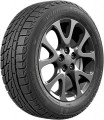The speed rating that the tyre corresponds to.
This indicator determines the maximum speed that tyre is allowed to operate. It is designated by the letters of the Latin alphabet, each of which corresponds to a certain speed limit:
F — 80 km/h; G — 90 km/h; J — 100 km/h; K — 110 km/h; L — 120 km/h; M — 130 km/h; N — 140 km/h; P —
150 km/h ; Q —
160 km/h ; R —
170 km/h ; S —
180 km/h ; T —
190 km/h ; U —
200 km/h ; H —
210 km/h ; V —
240 km/h ; W —
270 km/h ; Y —
300 km/h ;
The maximum permitted speed must not be exceeded — this creates the risk of an accident. However, there are other rules associated with choosing a tyre by this factor. So, ideally, the actual driving speed should be at least 10 – 15% lower than the speed rating of the installed tyres — this will give an additional guarantee in case of emergency situations. In addition, in some tyre models, as the speed approaches the maximum, the upper limit of allowable load is reduced; see “Load Index” for details.
The shape of the tyre tread pattern:
—
Directional. Pattern with a characteristic V-shape. Among other things, such rubber is considered to be especially effective on wet surfaces — in rain, on snow, with an abundance of melt water, etc.: the pattern provides effective water drainage, reducing the risk of hydroplaning and increasing grip. Also, these tyres are well suited for high-speed sports cars (although, of course, their speed rating and specialization may be different). When installing directional tyres, the direction indicated by the manufacturer must be kept.
—
Symmetric. The pattern without signs of directionality is the same both on the outer and on the inner part of the tread. These tyres are easier to manufacture than directional or asymmetric tyres, and are generally cheaper, while still having good performance on a flat and dry surface. In addition, symmetric tyres are as simple as possible to install, they do not need to follow the direction. However, for hard conditions, particularly wet weather, they are poorly suited. So, typically, such tyres are designed mainly for city cars used on short trips on relatively high-quality roads.
—
Asymmetric. Tyres with a different pattern inside and outside the tread. Each of these parts plays a role: the inner part provides water evacuation and reduces the risk of aquaplaning, while the ou
...ter part provides the necessary rigidity for manoeuvrability and stability. While installing, you need to take into account the location of the outer and inner sides, they usually have the appropriate marking. Asymmetric tyres are considered the most advanced, although, of course, the actual characteristics and cost of such products may vary, depending on the brand and the general level. Such tyres are designed mainly for cars of medium and top levels; they are often supplied as factory equipment for advanced cars.The average noise level created by a tyre while driving. The lower this indicator, the more comfortable this model will be, the less additional noise it will create.
Note that EU rules provide 3 categories of tyres in terms of noise.
“Quiet” are considered models with an index of up to 68 dB,
“medium” — 68 – 71 dB,
“loud” — 72 dB and above.

